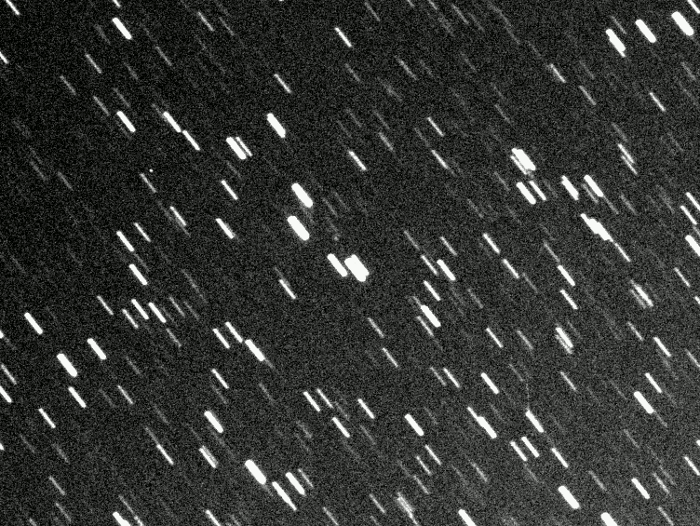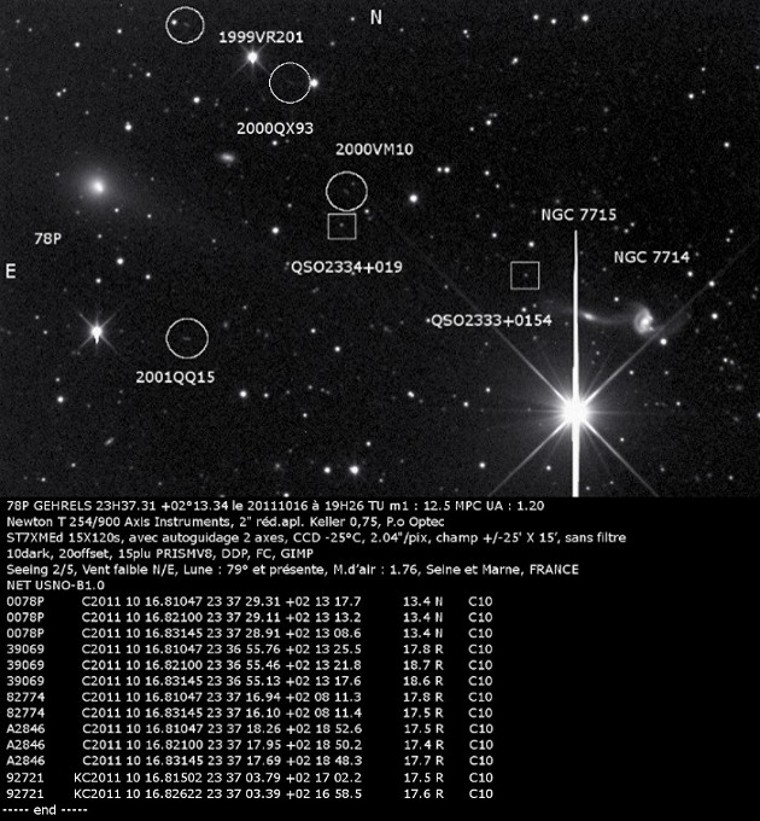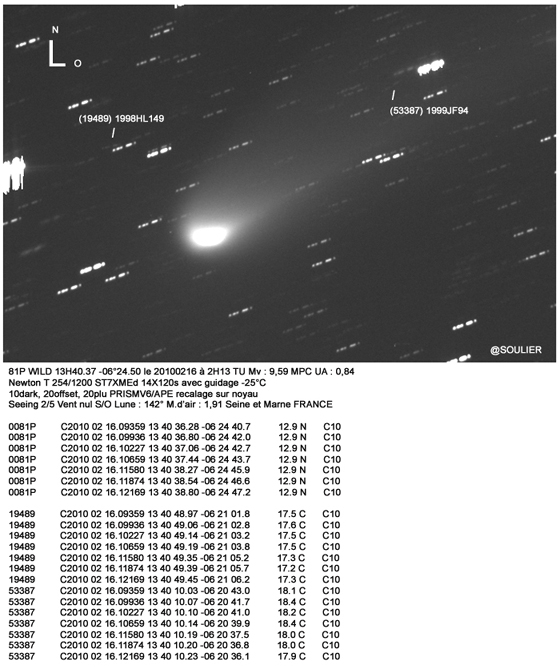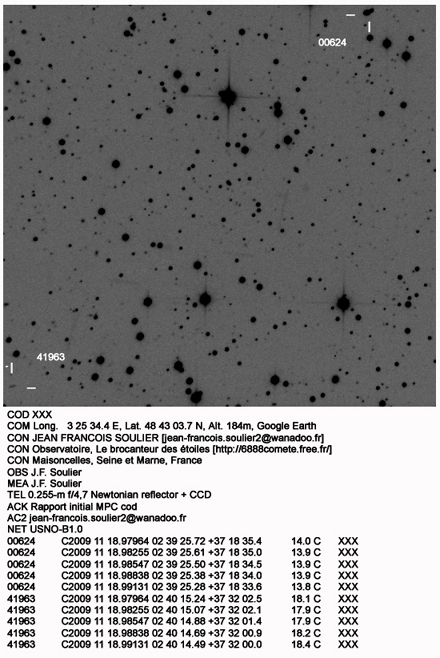

 Animation 6x(10x30s)
Animation 6x(10x30s)
COD C10
OBS J.-F. Soulier
MEA J.-F. Soulier
TEL 0.30-m f/3.8 Newtonian reflector + CCD
NET UCAC-4
JF-GAIA KC2013 12 20.76085 05 40 21.119+13 08
51.37
17.58R C10 10.7"/min
56°
JF-GAIA KC2013 12 20.76647 05 40 26.141+13 09
37.64
17.43R C10
10"/min 55°
JF-GAIA KC2013 12 20.77203 05 40 30.748+13 10
23.13
17.63R C10 9.9"/min
54°
JF-GAIA KC2013 12 20.77730 05 40 34.930+13 11
05.78
17.06R C10* 9.8"/min
53°
JF-GAIA KC2013 12 20.78275 05 40 39.094+13 11
49.80
18.07R C10* 9.7"/min
52°
JF-GAIA KC2013 12 20.78820 05 40 42.822+13 12
32.93
17.70R C10 9.4"/min
51°
----- end -----
* close to a star
 Animation 10x(10x30s)
Animation 10x(10x30s)
COD C10
OBS J.-F. Soulier
MEA J.-F. Soulier
TEL 0.30-m f/3.8 Newtonian reflector + CCD
NET UCAC-4
JF-GAIA KC2013 12 20.79982 05 40 50.089+13 14
03.04
17.72R C10
8.5"/min 42°
JF-GAIA KC2013 12 20.80524 05 40 53.045+13 14
43.82
17.69R C10
8.45"/min 42°
JF-GAIA
KC2013 12 20.81072 05 40 55.884+13 15
25.03
17.46R C10
7.8"/min 41°
JF-GAIA
KC2013 12 20.81621 05 40 58.409+13 16
05.72
17.47R C10
6.8"/min 40°
JF-GAIA
KC2013 12 20.82172 05 41 00.741+13 16
45.96
17.29R C10
5.8"/min 39°
JF-GAIA
KC2013 12 20.83263 05 41 04.662+13 18
02.21
17.31R C10*
JF-GAIA
KC2013 12 20.83802 05 41 06.295+13 18
40.27
17.57R C10
5"/min 36°
JF-GAIA
KC2013 12 20.84332 05 41 07.725+13 19
16.13
17.81R C10*
4.8"/min 36°
JF-GAIA
KC2013 12 20.84880 05 41 08.906+13 19
52.70
17.75R C10
4.8"/min 35.5°
----- end -----
* close to a star
2013 PS 13
is a potential radar target in the next couple of days.
Right now
the 3-sigma pointing uncertainties are enormous, but it's possible
that they
might shrink enough for us to observe it with radar if
observers can obtain
optical astrometry in the next ~14 hours before this
asteroid gets too close
to the Sun to observe.
Here's a geocentric ephemeris at 1-hour intervals
computed using the JPL/Horizons system:
Date__(UT)__HR:MN
R.A._(J2000.0)_DEC. delta APmag S-O-T /r T-O-M/Illu%
2013-Aug-08 19:00
330.16499 -0.48396 0.00451944808036 16.85 160.7795 /L 171.5/ 3.6
2013-Aug-08
20:00 331.21594 0.92593 0.00412452035453 16.70 159.0540 /L 171.3/
3.8
2013-Aug-08 21:00 332.48918 2.63193 0.00373421161435 16.55 156.9586 /L
170.8/ 3.9
2013-Aug-08 22:00 334.06193 4.73060 0.00335014571661 16.39
154.3712 /L 169.9/ 4.1
2013-Aug-08 23:00 336.05062 7.36028 0.00297475486812
16.23 151.1142 /L 168.3/ 4.3
2013-Aug-09 00:00 338.63827 10.72104
0.00261180171840 16.07 146.9258 /L 165.5/ 4.4
2013-Aug-09 01:00 342.12663
15.09887 0.00226729605183 15.91 141.4167 /L 161.3/ 4.6
2013-Aug-09 02:00
347.03996 20.87555 0.00195107698942 15.79 134.0220 /L 155.1/ 4.8
2013-Aug-09
03:00 354.33428 28.44048 0.00167926259303 15.75 124.0032 /L 146.1/
4.9
2013-Aug-09 04:00 5.76705 37.74656 0.00147666178118 15.87 110.7039 /L
133.7/ 5.1
2013-Aug-09 05:00 24.01948 47.16192 0.00137431587382 16.28 94.3722
/L 118.2/ 5.3
2013-Aug-09 06:00 49.73179 52.81176 0.00139452048125 17.09
77.0475 /L 101.7/ 5.5
2013-Aug-09 07:00 75.40457 52.36320 0.00153241948883
18.24 61.5618 /L 86.9/ 5.7
2013-Aug-09 08:00 93.59290 48.35377
0.00176051442929 n.a. 49.3593 /L 75.4/ 5.9
2013-Aug-09 09:00 104.97916
43.76687 0.00204883750195 n.a. 40.2720 /L 67.0/ 6.1
2013-Aug-09 10:00
112.24332 39.73897 0.00237550777400 n.a. 33.5590 /L 60.9/ 6.3
2013-Aug-09
11:00 117.13634 36.44620 0.00272673993981 n.a. 28.5289 /L 56.5/
6.5
2013-Aug-09 12:00 120.61026 33.79340 0.00309415387650 n.a. 24.6773 /L
53.2/ 6.7
2013-Aug-09 13:00 123.18713 31.64618 0.00347259780716 n.a. 21.6616
/L 50.8/ 6.9
 Animation 5Mb
Animation 5Mb
Observation K13P13S, 20130808, Seine and Marne, France
Newton Instrument T300, Focal Length : 1140mm, MPC code : C10/France
Cam. ST8XME, temperature -15°c
Echantillionnage : 1.62"/pixel
No Filter
Pretreatments yes, Mass Air : 2.58 early acquisitions
Unitary integration time : 60s
1 Measuring = Registration 4x60s
Radius opening measures 5", Astrometrica software
Able at the beginning of acquisition
COD C10
CON JEAN-FRANCOIS SOULIER [jean-francois.soulier2@wanadoo.fr]
OBS J.F. Soulier
MEA J.F. Soulier
TEL 0.30-m f/3.8 Newtonian reflector + CCD
ACK MPCReport file updated 2013.08.08 11:52:11 p.m.
AC2 jean-francois.soulier2 @ wanadoo.fr
NET UCAC-4
K13P13S KC2013 08 08.87584 22 11 30.22 +02 10 52.1 18.7 R C10
K13P13S KC2013 08 08.87919 22 11 57.34 +02 19 54.8 19.0 R C10
KC2013S K13P13 08 08.88277 22 12 27.28 +02 29 49.8 19.1 R C10
----- End -----
2012 DA 14
Époque 2012 novembre 30.0 TT = JDT 2456261.5
T 2012 novembre 30.02858 TT P. Rocher
q 0.893510224 (2000) P Q
n 0.982789963 Peri 271.0621512 0.51640506 -0.85082728
a 1.001910453 Noeud 147.2573597 0.83960820 0.48075406
e 0.108193530 Incl 10.3368429 0.16847517 0.21205773
P 1.00








Lune, Jupiter and Vénus le 2012 02 26 +/- 17H TU. Casio
pocket hand-held.









































Je rappelle que :